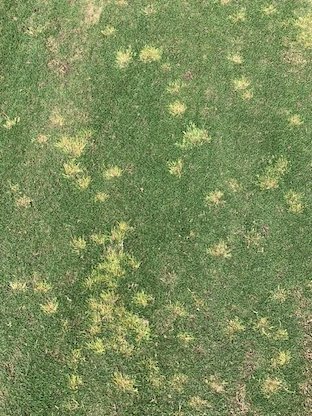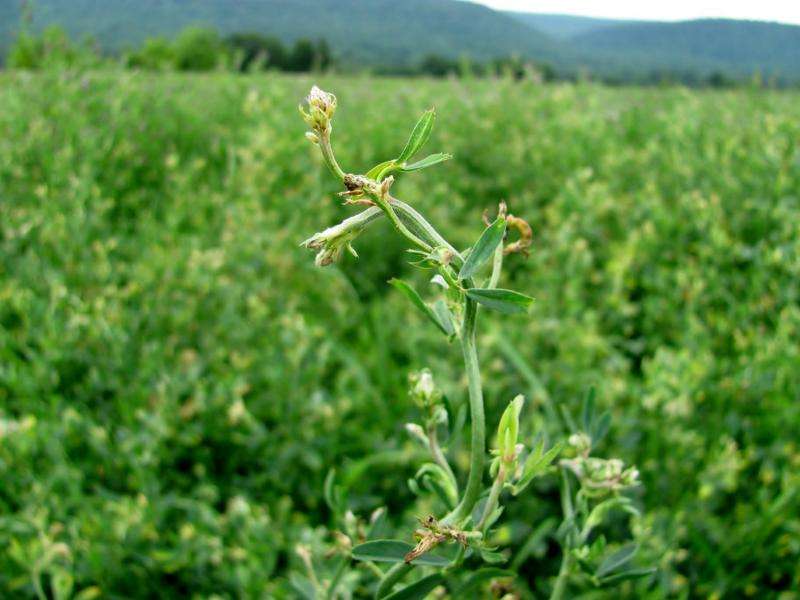Cracking the Code: Factors Shaping Herbicide Performance
- Herbicide selection
- The target weed species,
- Application timing
- Environmental considerations.
- How you apply it.
- Herbicide resistance
- Turfgrass tolerance
- Herbicide formulation and
- Future Plans.
Herbicide Selection.
Target weeds
Ways in which the target weeds impact herbicide performance:
Weed Sensitivity:
Different weed species have varying levels of sensitivity to herbicides. Some weeds are susceptible to a particular herbicide, while others are more tolerant. For example, Pigweed is tolerant to 2,4-D , in comparison to other broadleaf weeds.
Herbicide Mode of action:
Some herbicides target specific biological processes or enzymes, that are unique to certain weed species. If the target weed species lacks the target site or mechanism of action, then that herbicide will not work against that weed.
Dicamba is a broadleaf herbicide that primarily targets sensitive broadleaf weeds. It disrupts the growth and development of plant tissues. However, Oxalis exhibits a tolerance to dicamba, so you get poor control when you Dicamba for this weed.
Weed Growth stage:
How well a herbicide works against a target weed is also a result of its growth stage. Certain herbicides work when you apply them at specific stages of weed development.
For example, Quinclorac works well vs juvenile and mature Summer Grass, but not so well when it’s at the 2 to 4 tiller stage. So if you apply a herbicide at the wrong growth stage it may result in poor results.
Glufosinate is another example. When you use this as a non-selective herbicide for broad-spectrum weed control, it works best on young, actively growing weeds.
Weed size:
The size of the target weed is also a factor that affects herbicide performance. Large, and more developed weeds tend to have thicker cuticles and larger root systems. This affects herbicide absorption and translocation in the plant.
Some herbicides are less effective on larger weeds, due to less uptake or movement in the plant.
Herbicide Resistance:
Weed species that develop resistance to specific herbicides pose a significant challenge.
Application Timing.
Weed growth stage.
Different lawn herbicides affect weeds at specific stages of their growth. If you time herbicide use so that the target weeds are at their most susceptible stage, it leads to better control.
For example, some herbicides are more effective if you apply them to young, actively growing weeds. Others are more effective on mature weeds. So if you use herbicides too early or too late in the weed’s growth cycle, it can reduce their efficacy.
Turfgrass Growth stage.
Certain herbicides cause damage or stunt turf grass if you use them at the wrong time.
Environmental conditions.
Environmental conditions at the time of herbicide use also impacts their performance. Factors such as temperature, humidity, and rainfall all influence herbicide absorption, translocation, and break-down in target weeds.
If you use herbicides during unfavourable weather conditions it has a big impact on your results. Factors such as high temperatures, drought, or heavy rainfall, reduce herbicide efficacy or cause potential off-target movement.
Weed size.
The size of the target weeds affects herbicide performance. Some herbicides are more effective on small, actively growing weeds. Others need the weed to be larger for the best uptake and translocation in the plant.
If you apply herbicides too early when weeds are too small, it may result in inadequate control. In other cases, if you use them too late when the weeds are too large, it reduces the herbicide’s effectiveness.
Repeat Applications.
Some herbicides like MSMA or Poacure need several applications or follow-ups to givee effective control. The timing of these repeat applications is critical.
Herbicides often have specific intervals between applications, to target weeds at different growth stages or to control weeds as they emerge.
Environmental Factors.
Environmental conditions affecting herbicide performance:
Temperature.
Temperature has a big affect on herbicide performance. Some herbicides require a specific temperature range for the best performance. A great example of this is with diclofop-methyl to control Crowsfoot Grass.
The Destro label states to not use if temperatures are above 25C. High temperatures speed up the breakdown rate of some herbicides, and so stops them from working.
Conversely, low temperatures tend to slow down herbicide activity. This is the case with the sulfonylureas such as ProForce Duke, ProForce Recondo and Bayer Tribute.
When you use any herbicide, make sure you do so in the recommended temperature range to get the best results.
Humidity.
High humidity helps herbicides stay on the plant surface longer, and enhances their uptake. This is especially important for foliars.
In hot, humid conditions spray droplets evaporate slower. This means that any spray takes more time to dry, and so increases herbicide uptake.
Absorption and translocation of bentazone in turfgrass increases in humid conditions1Kudsk, P.; Kristensen, J. Effect of environmental factors on herbicide performance. In Proceedings of the First International Weed Control Congress, Melbourne, Australia, 17–21 February 1992; Weed Science Society of Victoria: Victoria, Australia, 1992; pp. 173–186. This is due to the cuticle being hydrated, which encourages herbicide absorption2Matzenbacher, F.O.; Vidal, R.A.; Merotto, A.; Trezzi, M.M. Environmental and physiological factors that affect the efficacy of herbicides that inhibit the enzyme protoporphyrinogen oxidase: A literature review. Planta Daninha 2014, 32, 457–463..
Hot, dry conditions have a greater impact on systemic herbicides, than on contact type products. However, very high humidity or long periods of leaf wetness will lead to herbicide runoff before uptake occurs.
This means that in hot and dry conditions, use of the right spray adjuvant or surfactant.
Adjuvants and surfactants enhance spray droplet retention on the leaf surface, and increase herbicide uptake. They dissolve wax cuticles, and hold spray droplets on the leaf for longer by reducing the evaporation rate.
Rainfall.
Rainfall or irrigation shortly after you apply a herbicide affects performance. Heavy rainfall or irrigation causes herbicide runoff, dilution, or it to leach. This reduces the concentration of herbicide available for weed control.
- S-metalochlor present in Pennmag quickly moves out of sandy soils after heavy rain. This is because of its high solubility in comparison to Pendimethalin.
Wind.
Wind affects the spray pattern and distribution of herbicides. Strong winds cause herbicide drift, that leads to non target deposition of herbicides.
Herbicide drift results in damage to desirable plants, crops, or adjacent sensitive areas.
That’s why you use drift control agents to reduce spray drift. These increase the average droplet size, and form larger spray droplets.
Soil conditions.
Soil conditions have a big impact on herbicide performance. This is especially the case with soil-applied herbicides such as pre-emergent herbicides.
Factors such as soil moisture, organic matter content, and pH impact herbicide availability, absorption, and degradation in the soil. Additionally, soil texture and structure affect herbicide movement.
- Foramsulfuron (Tribute Selective herbicide) works best on Crowsfoot grass under conditions of high soil moisture and high evaporation. In sandy soils results are affected.
Correct Herbicide Application.
- The spray volume that you use.
- The spray droplet size and
- The nozzle selection,
These are all important to get good coverage and reduce drift. A good example of this is the use of dicamba, and herbicide formulations that contain this, like Contra M.
You use Dicamba for broadleaf weed control in turf grass. Drift onto non-target areas, such as ornamental plants or sensitive vegetation, causes non-target damage or injury.
Herbicide Resistance.
Turfgrass Tolerance.
How Turfgrass Tolerance effects Herbicide Performance:
Selectivity.
Selective lawn herbicides control specific weeds and minimise the damage to desirable turf grass. Take for example the selectivity of the sulfonylurea herbicides on warm season turf.
Their selectivity allows you to use these to remove turf type ryegrass from oversown sports grounds, when you transition back to couch in the Spring.
Safety margin.
Herbicide labels often provide specific use rates for different turf grass species or cultivars. These rates are a direct result of turfgrass tolerance, and are the range of herbicide rates that do not cause turf injury. The herbicide formulation also plays a role with SC formulations being generally safer than EC formulations.
Recovery and regrowth.
Tolerant turf grass has the ability to recover after herbicide use. Even if some injury occurs, tolerant turfgrass recovers and resumes normal growth.
Herbicide options.
Turfgrass tolerance to herbicides affects what you can use. Certain turfgrass species or cultivars have a higher tolerance to specific herbicides. This allows effective control of target weeds without any significant damage to the turf.
If you understand the tolerance of your turf grass to different herbicides, It helps in herbicide selection for your specific weed control needs. Examples of this are:
- Bispiribac sodium. There is a big difference between the tolerance of turf type perennial ryegrass cultivars.
- Oxadiazon. You can’t use this on Santa Anna couch, but It is safe on all other hybrid couch varieties.
Herbicide Formulation.
- A good example of this is Onset 10GR. This is a pre emergent granular formulation of prodiamine. The herbicide formulation is Barricade herbicide.
Planning ahead.
FAQ
What are the main factors which affect herbicide selectivity?
- Plant species may differ in their growth habits.
- Herbicides may be applied at different times by different methods.
- Use of antidotes and adsorbents to prevent herbicide uptake by non target plants.
- Herbicide formulations may differ in their ability to contact with non target plants.
- Even though equal amounts of herbicide may be taken up by plants and weeds the rate they move inside the plant (translocate) may be different.
- Faster translocation does not necessarily mean it kills the plant quickly. In some instances it can mean it is an escape mechanism to avoid herbicides.
- A change in the molecular structure of a herbicide inside a plants.
- Intermediate compounds are more phytotoxic than the original herbicide that was applied.
- The herbicide binds with plant cell constituents inside the living plant
What are the reasons for poor herbicide performance?
There are several factors that can affect herbicide performance. These can be classed as environmental factors, plant factors and management factors
Environmental factors like sunlight, temperature, water stress and quality, humidity, temperature and sunlight all impact on herbicide performance. In general conditions that favour plant growth also favour herbicide performance.
- Sunlight. Plant cuticles (the outermost protective waxy layer of a leaf) thicken when plants are subjected to continous high light levels. This in turn makes the absorption of some water-soluble herbicides more difficult.
- Temperature. Assuming turf is not under any moisture stress, temperatures below 35 °C, increase the uptake and activity of many herbicides. The actual amount absorbed is generally not affected but the rate of uptake increases. Warm temperatures also speed up the activity of a herbicide.
- Humidity. High humidity reduces spray drift and slows the droplet drying time. This means it takes longer for a herbicide to enter a plant. Plants that grow in high humidity tend to have thinner cuticles, which causes a much faster absorption of chemicals. High humidity also enables many plants to grow faster, so herbicides are moved to their activity sites faster.
- Moisture stress. A lack of moisture reduces the movement of nutrients and water in the plant, which reduces the effectiveness of systemic herbicides. Plants growing under moisture stress tend to have thicker cuticles which reduces the absorption of herbicides.
- Physical barriers. In dry conditions there may be a layer of dust or dirt on the leaves. This can form a physical barrier that stops a herbicide entering into a leaf. The nature of the soil can affect the performance of pre-emergent herbicides.
- Rainfall/Irrigation. When rainfall or irrigation washes dust or dirt off a leaf its gives a herbicide a better target surface. It also is vital for pre-emergent herbicides to work as they need to be watered into the soil. The rain fastness of post emergent herbicides also varies greatly, and changes with weed species.
- Water Quality. Water quality affects how well a spray works. Factors such as pH, whether its hard or soft, and its clarity (turbidity) have a big impact on herbicide performance.
When should I apply my lawn pre emergent?
The best time to apply these products is in the early spring as this is before broadleaf weeds begin to grow. For grass weeds like summer grass apply later say in late spring or early summer. This weeds germinate later, so by applying your pre emergent later you will get longer control.
What is a turf herbicide?
Turf herbicides, also known as weedkillers are pesticides used to control and manage undesirable plants. It is important that when you use a turf herbicide that you precisely follow the label directions. If you don’t do this then the herbicide may fail to control the target weed, damage the turf grass or even prevent you from being able to reseed or re-turf damaged areas.
Turf herbicides can be:
- Selective or non selective. Selective turf herbicides are able to specifically target the weed without damaging the desirable turf grass. Non selective turf herbicides kill everything.
- Pre emergent or post emergent. Pre emergent turf herbicides prevent weeds from growing and becoming and are used before weeds grow. Post emergent kill weeds after they have emerged.
- Work against broadleaf weeds or grass weeds.
References

Jerry Spencer
Jerry has an Hons Degree in Soil Science (1988) from Newcastle Upon Tyne University. He then worked as a turf agronomist for the Sports Turf Research Institute (STRI) until 1993.
He gained a Grad Dip in Business Management from UTS in 1999. He has held a number of technical roles for companies such as Arthur Yates (Commercial Technical Manager) and Paton Fertilizers (Organic, turf specialty and controlled release fertiliser) portfolios.
In 2013 he established Gilba Solutions as independent sports turf consultants and turf agronomists. Jerry has written over 100 articles and two books on a wide range of topics such as Turf Pesticides and turfgrass Nutrition which have been published in Australia and overseas.


